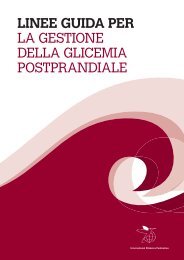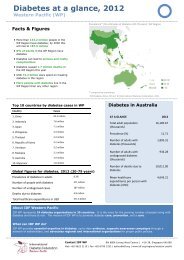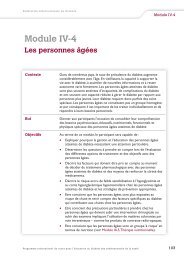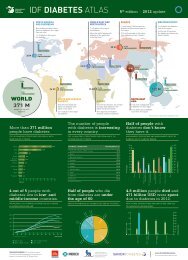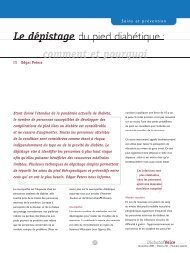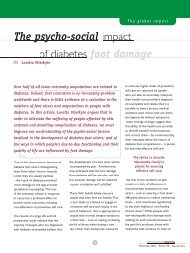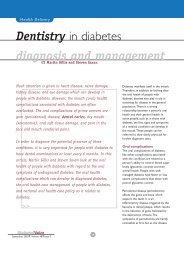Global guideline on pregnancy and diabetes - International ...
Global guideline on pregnancy and diabetes - International ...
Global guideline on pregnancy and diabetes - International ...
Create successful ePaper yourself
Turn your PDF publications into a flip-book with our unique Google optimized e-Paper software.
<str<strong>on</strong>g>Global</str<strong>on</strong>g> Guideline <strong>on</strong> Pregnancy <strong>and</strong> Diabetes<br />
from tablets or electing to be treated with insulin, if diet<br />
al<strong>on</strong>e is inadequate, will also need careful advice about<br />
their carbohydrate choices. The same observati<strong>on</strong>s about<br />
carbohydrate regulati<strong>on</strong> apply to women diagnosed with<br />
GDM [60,61].<br />
There may be an involuntary decrease in energy intake at<br />
the beginning of the <strong>pregnancy</strong> related to nausea. Later<br />
in <strong>pregnancy</strong> the total energy requirements are likely to<br />
increase. For those women who are insulin treated, there<br />
is likely to be an increase in the total dose of insulin during<br />
the <strong>pregnancy</strong> related to the physiological decrease in<br />
insulin sensitivity. Thus the dietary carbohydrate c<strong>on</strong>tent<br />
<strong>and</strong> distributi<strong>on</strong> will need to be changing to fulfil nutriti<strong>on</strong>al<br />
requirements <strong>and</strong> as the insulin dose <strong>and</strong> type are changed.<br />
It is possible that maternal obesity could be associated<br />
with an increased risk of fetal abnormalities [62,63].<br />
Weight loss diets are in general not recommended during<br />
the course of a <strong>pregnancy</strong>. However, at least for women<br />
with GDM who are c<strong>on</strong>siderably overweight, reducing<br />
energy intake by no more than 30% of habitual intake<br />
[64] is not associated with ketosis <strong>and</strong> does not cause<br />
harm [65,66].<br />
The proporti<strong>on</strong> of energy intake derived from carbohydrates<br />
will vary depending <strong>on</strong> the traditi<strong>on</strong>al diet <strong>and</strong> the<br />
availability of alternative sources of energy. Regulating<br />
<strong>and</strong> potentially reducing the carbohydrate intake is an<br />
effective strategy for helping to c<strong>on</strong>trol glucose levels<br />
[67,68]. Changing the nature of the carbohydrates c<strong>on</strong>sumed,<br />
particularly with respect to the use of foods with<br />
a low glycaemic index (GI), can reduce the postpr<strong>and</strong>ial<br />
glucose excursi<strong>on</strong>s. For women with GDM, postpr<strong>and</strong>ial<br />
glucose elevati<strong>on</strong>s are associated with adverse <strong>pregnancy</strong><br />
outcomes [49,69]. In normal pregnancies, a low GI diet<br />
will result in a reduced rate of LGA babies [70,71]. For<br />
women with GDM, a low GI diet can reduce the rate<br />
of insulin use, with no compromise of obstetric <strong>and</strong><br />
fetal outcomes [72].<br />
4.3.2.2 Exercise<br />
A moderate amount of exercise is beneficial for most people<br />
most of the time, <strong>and</strong> <strong>pregnancy</strong> is no excepti<strong>on</strong>. The ‘expert<br />
opini<strong>on</strong>’ of ACOG was that a minimum of 30 minutes exercise<br />
<strong>on</strong> most days of the week was recommended during<br />
a normal <strong>pregnancy</strong> [73]. There is no indicati<strong>on</strong> that this<br />
opini<strong>on</strong>, with comm<strong>on</strong> sense precauti<strong>on</strong>s, would be any<br />
different for pregnant women with <strong>diabetes</strong>. Women who<br />
were exercising before <strong>pregnancy</strong> should be encouraged to<br />
c<strong>on</strong>tinue this during the <strong>pregnancy</strong> though the extent <strong>and</strong><br />
type of exercise may need to be modified. For women with<br />
GDM, exercise can be seen as a useful adjunct to treatment<br />
[3,64,74]. Exercises that effectively avoid excessive abdominal<br />
muscular c<strong>on</strong>tracti<strong>on</strong> are preferred [59].<br />
Women who exercise regularly are probably less likely<br />
to develop GDM, although this reduced rate appears<br />
to be related to the habitual amount of exercise rather<br />
than exercise started in the year before the <strong>pregnancy</strong><br />
[75]. An exercise programme may be an alternative to<br />
the use of insulin in women with GDM who have not<br />
12<br />
Pregnancy_EN2.indd 12 16/09/09 15:42





